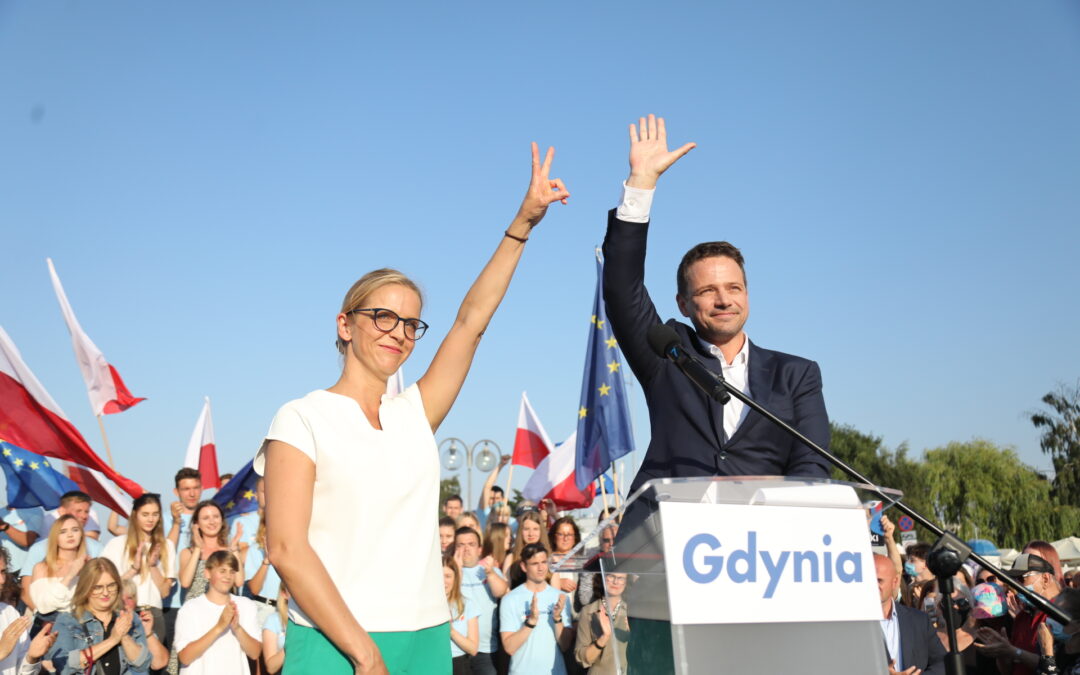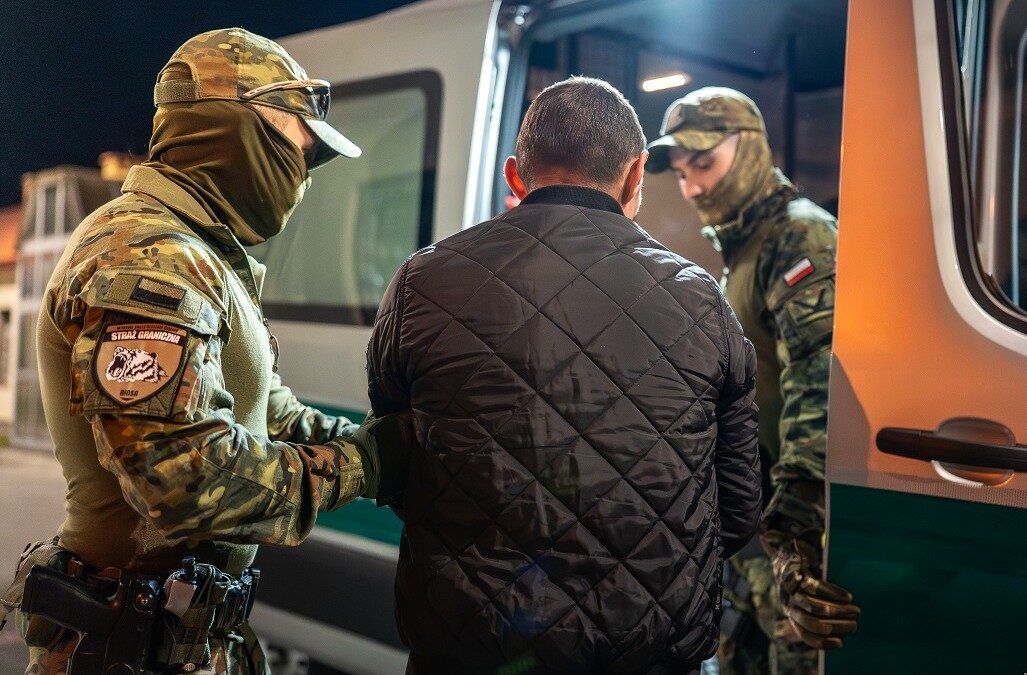By Aleks Szczerbiak
The Polish liberal-centrist opposition’s future prospects depend critically upon how Warsaw’s mayor builds on the political capital derived from his strong presidential election challenge.
But there are question marks over his proposed new civic movement’s relationship with the main opposition party, and he faces a challenge from an insurgent TV presenter-turned-politician, and strategic dilemmas over which model of opposition to adopt and how to develop an attractive alternative programme.
Trzaskowski’s strong challenge
In July, incumbent Andrzej Duda – who was backed by the right-wing Law and Justice (PiS) grouping, Poland’s ruling party since autumn 2015 – defeated Warsaw mayor Rafał Trzaskowski – the candidate of the liberal-centrist Civic Platform (PO), the governing party between 2007 and 2015 and currently the main opposition grouping – in a presidential election second round run-off by 51% to 49%.
The opposition now faces a three-year period of difficult soul-searching until the next elections and PiS has a clear run in control of all the main state institutions to continue implementing its radical state reconstruction programme.
However, Duda’s narrow margin of victory also shows that the opposition retains a sizeable base of support, especially in the larger towns and cities, and among well-educated, better-off, and (increasingly) younger Poles. At the same time, Trzaskowski’s result confirmed that PO continues to be the main challenger to the ruling party.
When the election, originally scheduled for mid-May, was postponed due to the coronavirus pandemic, Trzaskowski replaced PO’s struggling presidential candidate Małgorzata Kidawa-Blońska, who had seen her poll ratings slump to single figures. Kidawa-Błońska’s disastrous campaign provided an opportunity for other opposition candidates to emerge as the main challenger to Duda.
At one point, it appeared that this would be Władysław Kosiniak-Kamysz, the leader of the agrarian-centrist Polish Peasant Party (PSL, also know in English as Polish People’s Party) which, heading up the broader centre-right Polish Coalition (KP) electoral bloc, had performed surprisingly well in the most recent October 2019 parliamentary election, securing 8.6% of the votes. However, Kosiniak-Kamysz’s campaign failed to take-off and he ended up with only 2.4%.
Similarly, although The Left (Lewica) electoral alliance finished third in the 2019 election with 12.6% of the votes, regaining parliamentary representation after a four-year hiatus, the grouping’s presidential candidate, sexual minorities campaigner Robert Biedroń, also secured an extremely disappointing 2.2%.
Trzaskowski, on the other hand, proved to be a much more formidable campaigner and, picking up PO voters who were planning to abstain or vote for another candidate, quickly regained the mantle of main opposition challenger, securing 30.5% in the first round, and then almost defeated Duda in the run-off.
“New Solidarity”
The liberal-centrist opposition’s future prospects depend critically on how Trzaskowski builds upon this enormous political capital.
For sure, the opposition retains several important political assets, notably: a strong local government base, substantial financial resources and the backing of much of the privately-owned media, as well as significant influence within, and widespread support from, Poland’s cultural, legal and business elites, together with the sympathy of the EU political establishment and international opinion-forming media.
At the same time, the socio-economic fallout from the coronavirus pandemic has put a huge strain upon PiS’s ability to deliver on its popular programme of expanding social spending and welfare policies while maintaining strong economic growth and reducing the budget deficit.
In order to broaden the opposition’s base of support, Trzaskowski is planning to launch a new civic movement at the beginning of September provisionally called New Solidarity (Nowa Solidarność), based on the title of his election programme, where he set out his socio-economic and public spending priorities for Poland at a time of crisis.
The name is also an allusion to the 10-million strong original 1980-81 manifestation of the legendary anti-communist Solidarity trade union and social movement; Trzaskowski’s 49% vote share corresponded to more than 10 million votes.
The concept is rather vague at present but appears to involve building a civic movement allied to PO but focused primarily on local government leaders, in order to attract support from Poles who oppose PiS but do not identify with the current opposition groupings or traditional party politics more generally.
Defeated opposition presidential candidate @trzaskowski_ is launching a new movement "to defend civil society and independent institutions".
"Parties are not enough…We have to build a community…to fight for an open, tolerant and European Poland" https://t.co/1iO9IkRXUE
— Notes from Poland 🇵🇱 (@notesfrompoland) July 17, 2020
Maintaining momentum will be difficult
However, although Trzaskowski is now Poland’s most popular opposition politician, it will be very difficult for him to maintain the momentum from his presidential campaign for the next three years.
Trzaskowski is not a member of parliament, which will continue to be the main arena for political contestation and debate. Although the post of Warsaw mayor gives him a high-profile political platform, Trzaskowski’s performance of this role will now come under much more intense national scrutiny.
It will be a major challenge for him to combine this post with the role of de facto national opposition leader: if he devotes too much time to building up his new civic movement then he will inevitably be criticised for neglecting his mayoral responsibilities. Indeed, there are question marks over whether Trzaskowski actually has the staying power to stick with the civic movement project for such a long haul.
Moreover, it is a convenient myth that Trzaskowski personally secured the support of 10 million voters. His second-round base of support was actually very heterogeneous and united around Trzaskowski primarily as a means of voting out the PiS-backed incumbent. This makes it very difficult for Trzaskowski to craft a programmatic appeal and ideological platform that such a diverse group of voters can identify with.
Some hope the 10m votes Trzaskowski (RT) got can form the basis for a revived opposition. The problem is, most were anti-Duda (AD) votes, not pro-RT
In a poll, 70% of RT voters said he was "not ideal but the lesser evil"; 56% said they were voting against AD rather than for RT pic.twitter.com/3scGPV4ULT
— Daniel Tilles (@danieltilles1) July 21, 2020
New Solidarity is certainly an attractive label, but it is unclear what precise organisational form it will take. Beneath the packaging, the new movement could simply be a vehicle for maintaining PO’s hegemony over the rest of the opposition; indeed, some commentators argue that the party is actually more interested in achieving this objective than defeating PiS.
More broadly, it is very difficult to build a genuine grassroots civic movement from the top down. Successful ones generally emerge spontaneously driven by new ideas, issues or interests that are not being articulated in mainstream politics.
In post-communist Poland, they have often been very transitory phenomena. For example, following a brief period when it organised a number of large street demonstrations, the Committee for the Defence of Democracy (KOD), an earlier attempt to build a broad grassroots anti-PiS civic movement during the previous 2015-19 parliament, fizzled out very quickly.
Any political strategy aimed at using Trzaskowski’s presidential election vote to expand the opposition’s base must also include revamping PO. Although it remains Poland’s main opposition grouping, PO has a very negative image because of its association with the previous unpopular administration which Poles rejected decisively in 2015.
Not surprisingly, Trzaskowski tried (not entirely successfully) to hide his party affiliation during the presidential election campaign, even though he is one of PO’s deputy leaders.
However, PO made a poor start in its efforts to rebuild public trust when, in August, it was completely wrong-footed by PiS, which persuaded it to vote in favour of a draft law substantially increasing salaries and expenses for parliamentarians and other government and public officials.
For more on MPs' move to raise their own pay by 60%, as well as to double the salaries of the prime minister and president, see our report from Friday https://t.co/2G6nriABcR
— Notes from Poland 🇵🇱 (@notesfrompoland) August 17, 2020
Given that Poland is currently facing a major economic downturn, this led to a huge backlash even among commentators sympathetic to the opposition (in the event, the proposal was abandoned when PO U-turned and the opposition-controlled Senate rejected it).
Moreover, it will be difficult for Trzaskowski to reform PO to fit in with his own political project unless he can develop an effective working relationship with party leader Borys Budka. Budka’s leadership position is very insecure and was only saved by Trzaskowski’s relatively good presidential election performance, so he is wary that the Warsaw mayor’s plans could further undermine his authority within the opposition camp.
Being manoeuvred into supporting the draft law on increasing public officials’ salaries put Budka’s troubled leadership in further doubt, and it is likely that he will be replaced as PO parliamentary caucus leader in the autumn.
Hołownia’s challenge
The formation of New Solidarity is also, in part, an attempt to stymie the challenge to PO from Szymon Hołownia, the TV presenter, writer and humanitarian activist known for his liberal Catholic views, who stood as an independent candidate in the presidential election.
In fact, although Hołownia’s campaign was very professionally managed – and his programme contained an eye-catching mix of policies focusing on environmental protection, national security, social solidarity, healthcare and raising standards in public life – it developed little traction until the coronavirus pandemic crisis turned conventional politics on its head.
By precipitating a shift from traditional campaigning – where local grassroots organisation, financial resources, and access to the traditional media favoured candidates from the more established parties – to political communication primarily through the Internet and social media, the crisis played to Hołownia’s strengths as a skilled direct-to-camera performer, and some polls even suggested that he could defeat Duda in a second round run-off.
Although Trzaskowski’s entry into the race limited Hołownia’s scope for picking up disillusioned PO voters, the TV presenter was still able to make an attractive pitch to the many Poles who craved a “new” non-party candidate, and finished a strong third with 13.9%.
Hołownia is now using his presidential election success as a springboard to create his own political movement, provisionally called “Poland 2050” (Polska 2050) to indicate a time horizon of more than one generation. However, Hołownia’s plans (like Trzaskowski’s) appear rather vague and it will also be very difficult for him to maintain political momentum and media interest without parliamentary representation.
In fact, Hołownia is not the first charismatic individual who has tried to shake up the Polish political scene in recent years. Such groupings have typically received an early poll boost, and sometimes gone on to secure parliamentary representation, before quickly disintegrating or being absorbed by one of the main parties.
An instructive recent example is that of right-wing rock star Paweł Kukiz who, standing as an independent “anti-system” candidate, secured 20% of the votes in the 2015 presidential election.
Although his Kukiz’15 grouping emerged as the third largest following the parliamentary election later that year, it only secured 9% support, and within four years he was forced to stand on the Peasant Party’s Polish Coalition slate to secure re-election for himself and his closest political allies.
In fact, at the end of August, the Ewybory website that aggregates voting intention surveys found support for Poland 2050 running at only 8%, compared with 26% for PO (and 40% for PiS).
Key strategic dilemmas
More broadly, the liberal-centrist opposition faces two key strategic dilemmas. Firstly, the question of how vigorously and comprehensively to oppose PiS’s reform programme and policy agenda? Here it has often sent confusing signals.
For example, knowing that a lot of the opposition’s radical anti-PiS rhetoric was off-putting for Poles who feared further political de-stabilisation, during the presidential election Trzaskowski tried to reassure more moderate conservative-centrist voters by invoking the rhetoric of reconciliation and political unity.
On the other hand, the government’s hard-core opponents expect a confrontational approach and the ramping up of so-called “total” opposition, reflected in the fact that PO leaders partially boycotted Duda’s presidential swearing-in ceremony. Secondly, and perhaps most importantly, the opposition also has to develop an attractive and convincing programmatic alternative on the socio-economic issues that Poles care most about.
Up until now it has been on the defensive on programmatic issues: Trzaskowski only published his (rather thin) presidential election manifesto two days before the first round of voting. To mount an effective challenge it will have to put some more programmatic flesh on its clever but vague concepts and slogans such as “new solidarity”.





















